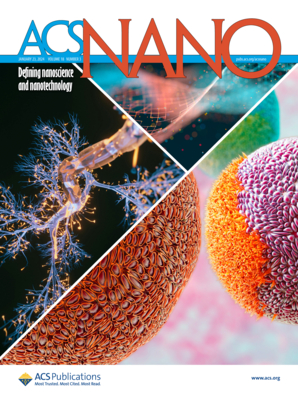Wireless Thermochromic Platform Based on Au/SiO2 Photonic Crystals for Operando Monitoring of Catalyst Sintering with Machine Learning
IF 15.8
1区 材料科学
Q1 CHEMISTRY, MULTIDISCIPLINARY
引用次数: 0
Abstract
Operando monitoring of the catalyst sinter-degree during reactions is essential for achieving a stable, safe, and efficient chemical engineering process. This work introduces a wireless thermochromic platform that utilizes machine learning to correlate color changes with the sinter-degree of catalysts and to identify hot spots during chemical reactions. After being decorated with sub-2 nm Au clusters, SiO2 photonic crystals were endowed with a distinct color change from the inherent blue hue of SiO2 photonic crystals to the distinctive red shade associated with Au clusters, due to the gradual growth of Au clusters over a wide temperature range from 25 to 900 °C. With the assistance of an artificial neural network, a robust correlation was established between the observed color change and the sinter-degree of Au species. After training, the smart Au/SiO2 catalyst achieved self-visualization for the sinter-degree of Au species within 12.4 μm × 12.4 μm, during CO oxidation. Moreover, an intelligent noninvasive platform can be constructed by patterning Au/SiO2 photonic crystals into quick response codes, for real-time monitoring of temperature distribution at a micro-region scale (208 μm × 208 μm) within 5 ms during chemical reactions. The Au/SiO2 thermochromic platform enables wireless data transmission and facilitates the programmable warning of abnormal hot spots in reactors. This work serves as a technical reserve for future research on the development of advanced catalysts and offers further insight into the chemical engineering process.

求助全文
约1分钟内获得全文
求助全文
来源期刊

ACS Nano
工程技术-材料科学:综合
CiteScore
26.00
自引率
4.10%
发文量
1627
审稿时长
1.7 months
期刊介绍:
ACS Nano, published monthly, serves as an international forum for comprehensive articles on nanoscience and nanotechnology research at the intersections of chemistry, biology, materials science, physics, and engineering. The journal fosters communication among scientists in these communities, facilitating collaboration, new research opportunities, and advancements through discoveries. ACS Nano covers synthesis, assembly, characterization, theory, and simulation of nanostructures, nanobiotechnology, nanofabrication, methods and tools for nanoscience and nanotechnology, and self- and directed-assembly. Alongside original research articles, it offers thorough reviews, perspectives on cutting-edge research, and discussions envisioning the future of nanoscience and nanotechnology.
 求助内容:
求助内容: 应助结果提醒方式:
应助结果提醒方式:


